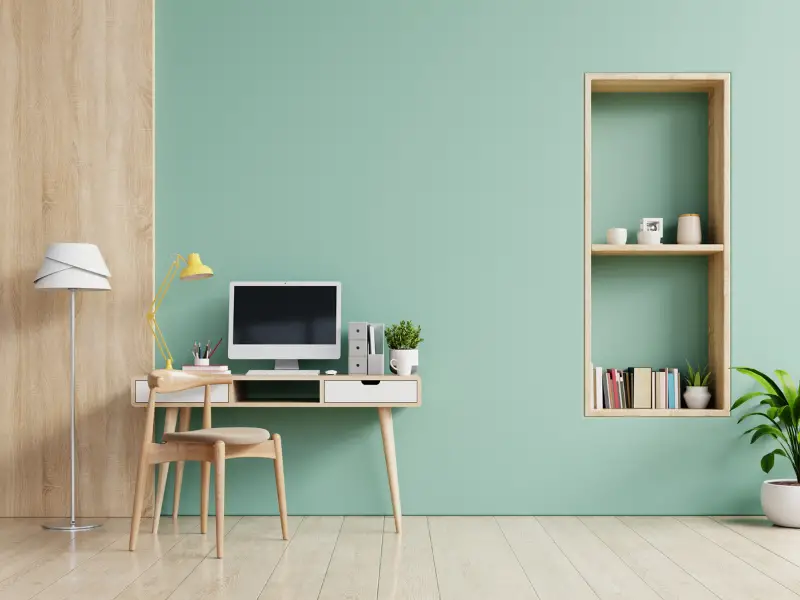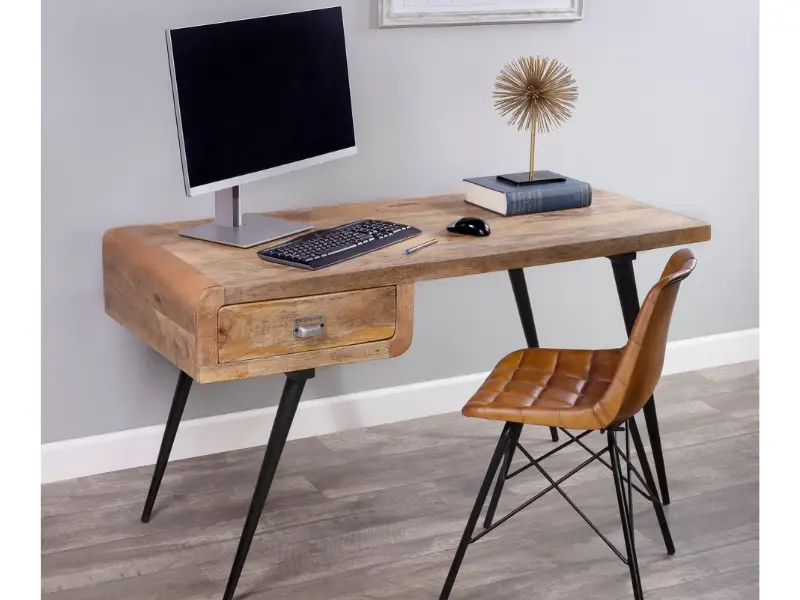Ever stared at a pile of paperwork on your desk and wished for an escape? Ever felt the chaos of cables tangled like spaghetti around your feet? You’re not alone.
Creating a functional home office is more than just setting up a desk in the corner. It’s about designing an environment that encourages productivity, keeps distractions at bay, and helps you stay organized. But where to start?
In this journey together, we’ll explore ways to maximize natural light for improved mood and efficiency. We’ll delve into organizing strategies that turn chaotic messes into streamlined workspaces. You’ll discover various desk styles to suit your taste, from mid-century modern to minimalist designs. Even limited spaces can be transformed into something special.

Creating a Functional Home Office
A functional home office is not just about having a desk and chair. It’s about creating an environment that boosts productivity, work efficiency and happiness. This means considering your specific work needs, from the layout of your office space to the type of supplies you need.
Understanding Specific Work Needs
To create an effective workspace, it’s essential to understand what you actually need for your job. Are you doing design work that requires large monitors? Paperwork that necessitates ample storage? You might even be looking for space-saving solutions like Murphy beds for your office. Whatever the challenge is, there’s probably an innovative solution.
Your functional home office should accommodate these needs seamlessly without feeling cluttered or cramped. For instance, if paperwork is part of your daily routine, consider filing cabinets or shelving units as part of your office decor.
The idea isn’t to fill every inch with furniture, but rather prioritize function over form. This approach will significantly enhance overall productivity.
Finding The Right Furniture
In any productive workspace, comfortable and ergonomic furniture plays a crucial role in maintaining focus throughout long working hours. At Archic Furniture, they have curated high-end desks and chairs designed specifically for extended use while providing maximum comfort.

Apart from comfort, the right desk can also affect productivity. Depending on your work style and the area you have available, maybe you’d prefer a plain metal desk or an acrylic one if you want to create a bold impression.
Natural Light And Productivity
Don’t underestimate the power of natural light in your home office. It’s a mood booster and productivity enhancer (source). So, when you’re getting your workspace sorted, make sure to let in as much daylight as possible.
Maximizing Natural Light in Your Home Office
The power of natural light cannot be overstated, especially when it comes to your home office. Studies demonstrate that introducing natural light can enhance productivity by a remarkable 40%. That’s no small potatoes.
The brightness of the room from natural light can have a positive effect on health as well as provide an energizing lift. It boosts vitamin D levels and improves mood, – important factors if you’re spending most of your day indoors working from home.
Tips to Harness the Power of Sunlight
Achieving a sunlit workspace isn’t as difficult as you might think. With smart planning and thoughtful design choices, even the gloomiest corner can become a sunny haven.
Your first step is simple: open those curtains or blinds wide. Maximizing exposure to outdoor views lets more sunshine stream into your workspace than any artificial source could provide.
Create A Gallery Wall with Reflective Elements
Mirrors are known for their ability to bounce around whatever little sunlight filters through windows. Why not incorporate them creatively into your work area? Building a gallery wall using mirrors along with art pieces adds personality while enhancing natural illumination—like hitting two birds with one stone.
Floor Lamps for After-Hours Work
Sometimes deadlines loom large and nighttime becomes work time too. This is where floor lamps come in handy, as they offer concentrated lighting that’s less harsh compared to overhead lights but still bright enough so you won’t strain those precious eyes.
Color Choices and Window Treatments
The right colors can have a significant impact on the brightness of your home office. Lighter shades reflect sunlight better than dark ones, making the room feel airy and open. And when it comes to window treatments, sheer curtains let more light in while still offering privacy.
Need a reason to give your workspace a makeover or start fresh? Prioritize ‘maximizing natural light’. It’ll not only brighten the room but also…
Organizing Your Workspace for Efficiency
A well-organized workspace can do wonders for your productivity. But, keeping everything in its place is easier said than done, especially when dealing with a plethora of desk accessories and documents.
The key to efficient organization lies not just on the surface but also above it. Utilizing vertical space through shelving units can help declutter your work area significantly. Here are some tips that might help you maintain an organized office environment.
The Magic Maximum: Five
According to research, having more than five items on your desk can lead to distraction and decreased productivity. So aim for this magic number – one computer (or laptop), a notepad or planner, two essential stationery items like a pen and highlighter, and perhaps a motivational item such as a family photo or small plant.
If you find yourself struggling limiting the number of items on your desk to five, remember there’s always room upward. Consider adding shelves right above your workspace where these files can be neatly stacked yet easily accessible whenever needed.
Taming Tech Cables
No matter how tidy we keep our desks, those pesky tech cables have their way of creating clutter. If left unchecked, they quickly transform into an unsightly mess, which isn’t very appealing visually and doesn’t contribute positively to efficiency at work due to the time wasted untangling them every now and then.
- An easy fix is to use cable clips that stick onto the side or back of desks, ensuring wires stay separated and orderly while remaining within reach when needed.
- You may also consider investing in wireless gadgets wherever possible – mouse keyboards, speakers, and even charging pads. The fewer the cables, the tidier your workspace.
Declutter Regularly
Once all is in order, it’s critical to maintain neatness. But let’s be honest; a bit of clutter is inevitable when we’re in work mode. Hence, regular decluttering becomes necessary for maintaining an efficient workspace.
Exploring Various Desk Styles and Materials

Your workspace isn’t just about function; it’s also an extension of your personal style. From mid-century modern designs to sleek, pared-down minimalist styles, the desk you choose can make a bold statement.
The mid-century modern aesthetic, with its emphasis on organic shapes and clean lines, has seen a resurgence in popularity. These desks often use warm wood tones that add depth and character to any office space. They offer both form and functionality – they’re not just stylish but designed for practicality too.
Minimalism, on the other hand, focuses on simplicity and utility. Minimalist desks tend to feature straightforward designs without unnecessary details or ornamentation—perfect for those who appreciate understated elegance.
Metal Desks: Durability Meets Design
Metal desks are robust workstations built to last through years of use. With their industrial charm combined with high durability, metal desks have found favor among professionals seeking long-lasting furniture solutions.
Beyond their longevity, though, is an inherent flexibility in design that few materials match up against metal’s ability. Metal allows creativity like no other—from raw steel finishes evoking rustic chic vibes all the way down to polished chrome surfaces reflecting minimalist sensibilities beautifully.
Aesthetic Appeal of Acrylic Desks
If there’s one material known for its distinctive visual appeal as well as versatility, it would be acrylic. Acrylic offers some unique benefits compared to traditional wooden or metal desks. The clear, glass-like aesthetic of acrylic desks creates a sense of openness and space, making them ideal for smaller offices.
Their lightweight design allows easy repositioning when you need to shake up your workspace aesthetics. Despite their lightness, these desks are surprisingly sturdy and can withstand daily use without showing much wear or tear.
A Desk Style For Every Office
No matter the size of your workspace, how often you move it, or what tasks will be completed on it, selecting a desk type and material is not only about personal preference but also practical considerations.
Whether you’re into mid-century modern or minimalist styles, there’s a wide range of options to choose from.
Making the Most of Limited Space for a Desk
Maximizing limited space, especially in home offices, can be a tricky endeavor. But fear not. There are plenty of innovative solutions to make your workspace both efficient and stylish.
The key is using what you’ve got wisely – this might mean rethinking those unused corners or office nooks. These often-overlooked areas have the potential to become productive spaces with just a bit of creativity.
Utilize Office Nooks
You’d be surprised at how much an office nook can do for your small space. With strategic planning, these cozy corners can turn into compact workstations that don’t compromise on functionality.
A floating desk or wall-mounted shelf does wonders for utilizing vertical space while keeping the floor free. Pair it up with sleek shelving above for storing books and supplies; it’s about making every inch count.
Choose Compact Furniture Wisely
Selecting the right furniture plays a huge role when dealing with limited space scenarios. A smart approach is to invest in pieces that offer multiple functions, like desks integrated with storage facilities such as drawers and cubbies.
Folding Desks: The Ultimate Space Saver
If flexibility is high on your list, consider folding desks. They allow you to create an instant workspace whenever needed, then pack it away after use – perfect if your office also doubles as another room.
Note: No matter which strategy suits your needs, the goal is to create a workspace that not only fits into your home but also encourages productivity and efficiency.
Optimize Your Storage
In any office, storage is key. In small spaces, though, it becomes even more crucial. Wall-mounted shelves or vertical filing systems help keep clutter at bay without eating up valuable desk space.
Conclusion
So, you’ve got the blueprint for crafting a functional home office that marries efficiency and style. Remember: it starts with understanding your specific work needs. Natural light is your new best friend – let it flood in to boost your mood and productivity. Organization strategies keep clutter at bay, making every inch of desk space count.
Different desk styles can set the tone of your workspace, from mid-century modern vibes to minimalist aesthetics. And never underestimate those nooks—they’re perfect for squeezing out extra room!



